Investigating the Effects of the Height-to-Diameter Ratio and Loading Rate on the Mechanical Properties and Crack Extension Mechanism of Sandstone-Like Materials
Abstract
:1. Introduction
2. Sandstone-Like Material
2.1. Preparation and Testing of Sandstone Specimens
2.2. Raw Materials
2.2.1. River Sand
2.2.2. Quartz Sand
2.2.3. α-High-Strength Gypsum
2.2.4. Water
2.3. Preparation of Gypsum-Mixed Sandstone-Like Specimens
- (1)
- First, combine the river sand and quartz sand, then shake the mixture on a vibrating table for 2 min to make it homogeneous.
- (2)
- Mix the gypsum powder evenly in the prepared water.
- (3)
- Gradually add the gypsum solution slowly to the aggregates and mix continuously at 30 r·min−1 until there are no flocculants or air bubbles in the slurry.
- (4)
- Apply petroleum jelly evenly to the inner wall of the mold to facilitate the release of the specimen.
- (5)
- Allow the slurry to mix thoroughly for 1 to 3 min and then pour into the mold.
- (6)
- In order to simulate the stress state and structural formation characteristics of sandstone in a large burial depth roadway, place the specimen after reaching initial solidification in the prepared closed cylindrical mold and press it into the corresponding size and shape with a constant pressure of 3~5 KN by using the WDW-50 electro-hydraulic servo tester (the pressure needs to be adjusted according to the actual burial depth of the roadway).where denotes the constant load applied by the press; is the average rock capacity; refers to actual burial depth of the rock formation; is the circumference of the circle; denotes the radius of the specimen cross-section; is the stress similarity ratio between sandstone and similar materials.
- (7)
- Remove the mold after the initial setting of the specimens, and put the specimens in a constant-temperature moisturizing curing box for 28 days.
- (8)
- Cut and polish the prepared specimens into eight groups of cylindrical specimens with a diameter of 50 mm and a height of 30 mm, 40 mm, 50 mm, 60 mm, 70 mm, 80 mm, 90 mm, and 100 mm in different HDRs, as shown in Figure 3; in total, 80 rock-like specimens were produced.
- (9)
- The allowable deviation of the height and diameter of the same group of specimens is 0.3 mm; that of the unevenness of the two ends’ surfaces is 0.05 mm; and the ends’ surfaces should be perpendicular to the axis of the specimen to allow a deviation of 0.25°.
2.4. Performance Comparison
3. Mechanical Experiment
3.1. Experimental Design and Method
3.2. Analysis of the Experimental Results
3.2.1. Different HDRs
UCS
Axial Peak Strain
3.2.2. Different LRs
UCS
4. Numerical Simulation
4.1. Model Configuration
4.2. Numerical Results
4.2.1. Different HDRs
4.2.2. Different LRs
5. Analysis for SE and LR Causes
5.1. The Mechanical Model
5.2. Discussions
6. Conclusions
- (1)
- The optimal ratio of the gypsum-mixed sandstone-like material is 7.5% river sand, 17.5% quartz sand, 58.3% -high-strength gypsum powder, and 16.7% water, respectively. Performance testing experiment have verified that the physical parameters of sandstone in a certain proportion can be simulated well, and the damage pattern is basically the same.
- (2)
- The curves were cut into two parts by a HDR of 1.2, and the R2 of the fitting parameters is greater than 0.9. The UCS displayed a changing trend that is M shaped, and the maximum value is obtained at a HDR of 0.6~1, although it does not monotonically decrease as the HDR increases. The peak strains show a W-shaped pattern in contrast to the UCS, which indicates that the stronger the gypsum-like material, the lower the peak strain. And when the HDR is less than 1, specimen damage shows X cross cracks and an increasing number of cracks. Mechanical analysis and numerical simulation results show that the main reason for the difference between UCS and previous studies is the generation of the EFE at a HDR of 0.6~1, which restricts the lateral deformation of the specimen and shows an effect of circumferential pressure, therefore increasing the ability of the specimen to resist deformation.
- (3)
- The UCS of the specimens at each SR stage shows roughly the same phased pattern of variation: first a decrease and then an increase. The rapid loading speed prevents cracks within the specimen so that they do not penetrate and converge in time, reducing the degree of destruction of the specimen, and thus increasing the ability of the specimen to resist external loading. For 50 mm·min−1, under the action of the EFE, the very fast rate results in multiple X-damage new cracks, but not complete fusion with the primary cracks, and the lateral deformation at the end of the specimen is also limited. The power consumed through the EFE significantly increases in 50 mm·min−1. Accordingly, its UCS value increases significantly.
- (4)
- Both experiments and numerical simulations have confirmed that the SE and LR did have an influence on the physical parameters of the sandstone-like specimens. By mechanical analysis, the EFE was generated during the loading process with a HDR of 0.6~1 and during dynamic loading phases, which was the root cause of the SE and the LR. Meanwhile, the results also showed that the power consumed as a result of the EFE increased as the HDR of the specimen decreased and the LR increased, which reduced the actual amount of energy transferred inside the specimen. In order to accurately obtain the physical parameters of real coal and rock and effectively avoid engineering disasters, the influence of the EFE should be mitigated as far as possible.
Author Contributions
Funding
Institutional Review Board Statement
Informed Consent Statement
Data Availability Statement
Acknowledgments
Conflicts of Interest
References
- Masoumi, H.; Saydam, S.; Hagan, P.C. Unified size-effect law for intact rock. Int. J. Geomech. 2016, 16, 04015059. [Google Scholar] [CrossRef]
- Zhao, Y.-S. Retrospection on the development of rock mass mechanics and the summary of some unsolved centennial problems. Chin. J. Rock Mech. Eng. 2021, 40, 1297–1336. [Google Scholar] [CrossRef]
- Weibull, W. A statistical function of wide applicability. J. Appl. Mech. 1951, 18, 293–297. [Google Scholar] [CrossRef]
- Weibull, W. A statistical theory of strength of materials. In IVB-Handl.; Generalstabens Litografiska Anstalts Förlag: Stockholm, Sweden, 1939; pp. 1–45. [Google Scholar]
- Bazant, Z.P. Size effect in blunt fracture: Concrete, rock, metal. J. Eng. Mech. 1984, 110, 518–535. [Google Scholar] [CrossRef]
- Liu, B.; Zhang, J.; Du, Q.; Tu, J. A study of size effect for compression strength of rock. Chin. J. Rock Mech. Eng. 1998, 17, 611–614. (In Chinese) [Google Scholar]
- Hoek, E.; Brown, E.T. Underground Excavations in Rock; Institute of Mining and Metallurgy: London, UK, 1980. [Google Scholar]
- Brace, W.F. The effect of size on mechanical properties of rock. Geophys. Res. Lett. 1981, 8, 651–652. [Google Scholar] [CrossRef]
- Carpinteri, A.; Chiaia, B.; Ferro, G. Size effects on nominal tensile strength of concrete structures: Multifractality of material ligaments and dimensional transition from order to disorder. Mater. Struct. 1995, 28, 311–317. [Google Scholar] [CrossRef]
- Zhang, M.; Lu, Y.; Yang, Q. Failure probability and strength size effect of quasi-brittle materials. Chin. J. Rock Mech. Eng. 2010, 29, 1782–1789. (In Chinese) [Google Scholar]
- Liang, Z.; Zhang, Y.; Tang, S.; Li, L.; Tang, C. Size effect of rock messes and associated representative element properties. Chin. J. Rock Mech. Eng. 2013, 32, 1157–1166. (In Chinese) [Google Scholar]
- Su, C.D.; Li, H.Z.; Zhang, S.; Gou, P. Experimental investigation on effect of strain rate on mechanical characteristics of marble. Chin. J. Rock Mech. Eng. 2013, 32, 943–950. (In Chinese) [Google Scholar] [CrossRef]
- Huang, D.; Huang, R.; Zhang, Y. Experimental investigations on static loading rate effects on mechanical properties and energy mechanism of coarse crystal grain marble under uniaxial compression. Chin. J. Rock Mech. Eng. 2012, 31, 245–255. (In Chinese) [Google Scholar]
- Zhang, J.; Ding, L.; Song, Z.; Fan, W.; Wang, S. Mechanical properties of deep sandstones under loading rate effect. J. Cent. South Univ. 2022, 29, 1933–1944. [Google Scholar] [CrossRef]
- Wang, Q.; Zhu, W.; Liu, H.; Niu Li, R. Size effect of long-term strength of sandstone under uniaxial compression. Rock Soil Mech. 2016, 37, 981–990. (In Chinese) [Google Scholar] [CrossRef]
- Zhang, B.; Li, S.; Yang, X.; Xia, K.; Liu, J.; Guo, S.; Wang, S. The coalescence and strength of rock-like materials containing two aligned X-type flaws under uniaxial compression. Geomech. Eng. 2019, 17, 47–56. [Google Scholar] [CrossRef]
- Yang, S.-Q.; Yin, P.-F.; Huang, Y.-H.; Cheng, J.-L. Strength, deformability and X-ray micro-CT observations of transversely isotropic composite rock under different confifining pressures. Eng. Fract. Mech. 2019, 214, 1–20. [Google Scholar] [CrossRef]
- Zhang, J.; Yang, Y. Rock size effect and acoustic emission characteristics under the influence of loading rate. China Min. Mag. 2021, 30, 205–210. [Google Scholar] [CrossRef]
- Darlington, W.J.; Ranjith, P.G.; Choi, S.K. The effect of specimen size on strength and other properties in laboratory testing of rock and rock-like cementitious brittle materials. Rock Mech. Rock Eng. 2011, 44, 513–529. [Google Scholar] [CrossRef]
- Hawkins, A.B. Aspects of rock strength. Bull. Eng. Geol. Environ. 1998, 57, 17–30. [Google Scholar] [CrossRef]
- Chen, P.; Zhou, Z. Size effect experiment of rock material with RFPA2D. J. Liaoning Tech. Univ. (Nat. Sci.) 2012, 31, 842–845. (In Chinese) [Google Scholar]
- Meng, Q.; Han, L.; Pu, H.; Li, H.; Wen, S.; Li, H. Effect of the size and strain rate on the mechanical behavior of rock specimens. J. China Univ. Min. Technol. 2016, 45, 233–243. (In Chinese) [Google Scholar]
- Aurelien, D.; Ronan, H.; Tanja, L.; Sylvain, M. Size effect assessment by Weibull’s approach and the coupled Criterion. Eng. Fract. Mech. 2021, 256, 107979. [Google Scholar] [CrossRef]
- Arcady, V.D.; Elena, P.; Qi, C.; Xia, C.; Qu, X. A possible mechanism of failure in dynamic uniaxial compression and the size effect. Eng. Fract. Mech. 2021, 257, 108005. [Google Scholar] [CrossRef]
- Cheng, H.; Zhou, X.; Zhu, J.; Qian, Q. The effects of crack openings on crack initiation, propagation and coalescence behavior in rock-like materials under uniaxial compression. Rock Mech. Rock Eng. 2016, 49, 3481–3494. [Google Scholar] [CrossRef]
- Luo, P.P.; Wang, S.R.; Hagan, P.; Huang, Q.X.; Cao, C.; Gamage, K. Mechanical performances of cement-gypsum composite material containing a weak interlayer with different angles. DYNA 2019, 94, 447–454. [Google Scholar] [CrossRef]
- Kou, M.; Liu, X.; Wang, Z.; Mohsen, N. Mechanical properties, failure behaviors and permeability evolutions of fissured rock-like materials under coupled hydro-mechanical unloading. Eng. Fract. Mech. 2021, 254, 107929. [Google Scholar] [CrossRef]
- Zhou, X.; Liang, F.; Hao, C.; Filippo, B. Cracking behaviours of rock-like materials containing three preexisting flaws after high-TEMPERATURE treatments. Fatigue Fract. Eng. Mater. Struct. 2021, 44, 622–635. [Google Scholar] [CrossRef]
- Haeri, H.; Khaloo, A.; Marji, M.F. Experimental and numerical simulation of the microcrack coalescence mechanism in rock-Like materials. Strength Mater. 2015, 47, 740–754. [Google Scholar] [CrossRef]
- Song, Y.; Liu, B.; Liu, H.; Sun, J.; Yu, M.; Ren, D. Orthogonal test method for determination of the proportion of rock-like material based on properties of deformation and brittleness. Rock Soil Mech. 2020, 41, 2675–2684. (In Chinese) [Google Scholar] [CrossRef]
- Zhang, Y.; Deng, H.; Deng, J.; Liu, C.; Yu, S. Peridynamic simulation of crack propagation of non-homogeneous brittle rock-like materials. Theor. Appl. Fract. Mech. 2020, 106, 102438. [Google Scholar] [CrossRef]
- Huang, Y.; Yang, S.; Liu, X. Experimental and numerical study on the mechanical characteristics of rock-like material. J. Exp. Mech. 2014, 29, 239–249. (In Chinese) [Google Scholar]
- Yin, P.; Yang, S. Experimental study on strength and failure behavior of transversely isotropic rock-like material under uniaxial compression. Geomech. Geophys. Geo-Energy Geo-Resour. 2020, 6, 44. [Google Scholar] [CrossRef]
- ISRM. The complete ISRM suggested methods for rock characterization, testing and monitoring. In Prepared by the Commission on Testing Methods; Ulusay, R., Hudson, J.A., Eds.; ISRM: Ankara, Turkey, 2007; pp. 1974–2006. [Google Scholar]
- Chang, Y.; Huang, P.; Wu, B.; Chang, S. A study on the color change benefits of sustainable green building materials. Constr. Build. Mater. 2015, 83, 1–6. [Google Scholar] [CrossRef]
- Zhou, Y.; Zhao, C.; Zhao, C.; Ma, C.; Xie, J. Experimental study on the fracturing behaviors and mechanical properties of cracks under coupled hydro-mechanical effects in rock-like specimens. Water 2018, 10, 1355. [Google Scholar] [CrossRef]
- Maqsood, Z.; Koseki, J.; Ahsan, M.K.; Shaikh, M.; Kyokawa, H. Experimental study on hardening characteristics and loading rate dependent mechanical behaviour of gypsum mixed sand. Constr. Build. Mater. 2020, 262, 119992. [Google Scholar] [CrossRef]
- Wang, P.; Jiang, L.; Li, X.; Qin, G.; Wang, E. Physical simulation of mining effect caused by a fault tectonic. Arab. J. Geosci. 2018, 11, 741. [Google Scholar] [CrossRef]
- Zhao, Y.; Cheng, Z.; Gao, Y.; Wu, S.; Chen, C. Review of geomechanical similar-material test systems. Arab. J. Geosci. 2020, 13, 906. [Google Scholar] [CrossRef]
- Wang, G.-F.; Li, G.; Dou, L.-M.; Mu, Z.-L.; Gong, S.-Y.; Cai, W. Applicability of energy-absorbing support system for rockburst prevention in underground roadways. Int. J. Rock Mech. Min. Sci. 2020, 132, 104396. [Google Scholar] [CrossRef]
- Zhuang, T.; Peng, R.; Zhao, Q.; Jiang, S.; Yang, X.; Shen, C.; Liu, J. Acoustic emission characteristic of sandstone and sandstone like material under multi-path loading. PLoS ONE 2024, 19, e0297087. [Google Scholar] [CrossRef]
- Diao, H.; Li, L.M.; Liang, J.; Ding, X. Screening of high-performance flocculant-producing bacteria and optimization of the conditions for flocculation of wheat distillery wastewater. Bioresources 2018, 13, 7738–7757. [Google Scholar] [CrossRef]
- Yan, H.; Wu, Y.; Li, S.; Zhang, L.; Zhang, K. The effect of factors on the radiation noise of high-speed full ceramic angular contact ball bearings. Shock. Vib. 2018, 2018, 1645878. [Google Scholar] [CrossRef]
- Mondal, D.; Jha, N.; Badkul, A.; Das, S.; Khedle, R. High temperature compressive deformation behaviour of aluminum syntactic foam. Mater. Sci. Eng. A-Struct. Mater. Prop. Microstruct. Process. 2012, 534, 521–529. [Google Scholar] [CrossRef]
- Liu, X.-H.; Huang, H.-Y.; Xie, J.-X. Effect of strain rate on the compressive deformation behaviors of lotus-type porous copper. Int. J. Miner. Metall. Mater. 2014, 21, 687–695. [Google Scholar] [CrossRef]
- Jordaan, M.S.; Kok, S. Material model calibration for superplastic forming. Inverse Probl. Sci. Eng. 2019, 27, 589–607. [Google Scholar] [CrossRef]
- Huang, R.; Li, S.; Meng, L.; Jiang, D.; Li, P. Coupled effect of temperature and strain rate on mechanical properties of steel fiber-reinforced concrete. Int. J. Concr. Struct. Mater. 2020, 14, 48. [Google Scholar] [CrossRef]
- Li, Y.; Bai, J.; Liu, L.; Wang, X.; Yu, Y.; Li, T. Micro and macro experimental study of using the new cement-based self-stress grouting material to solve shrinkage problem. J. Mater. Res. Technol. 2022, 17, 3118–3137. [Google Scholar] [CrossRef]
- Wu, T.; Gao, Y.; Zhou, Y.; Li, J. Experimental and numerical study on the interaction between holes and fissures in rock-like materials under uniaxial compression. Theor. Appl. Fract. Mech. 2020, 106, 102488. [Google Scholar] [CrossRef]
- Chen, S.; Xia, Z.; Feng, F.; Yin, D. Numerical study on strength and failure characteristics of rock samples with different hole defects. Bull. Eng. Geol. Environ. 2020, 80, 1523–1540. [Google Scholar] [CrossRef]
- Ma, Z.; Cheng, S.; Gong, P.; Hu, J.; Chen, Y. Particle flow code simulation of the characteristics of crack evolution in rock-Like materials with bent cracks. Geofluids 2021, 2021, 8889025. [Google Scholar] [CrossRef]
- Itasca Consulting Group Inc. PFC2D Theory and Background; Itasca Consulting Group Inc.: Minneapolis, MN, USA, 2008; pp. 20–80. [Google Scholar]
- Potyondy, D.O.; Cundall, P.A. A bonded-particle model for rock. Int. J. Rock Mech. Min. Sci. 2004, 41, 1329–1364. [Google Scholar] [CrossRef]
- Potyondy, D.O.; Cundall, P.A.; Lee, C.A. Modelling rock usingbonded assemblies of circular particles. In Proceedings of the 2nd North American Rock Mechanics Symposium, Montreal, QC, Canada, 19–21 June 1996; Auberrtin, M., Hassani, F., Mitri, H., Eds.; Balkema Press: Rotterdam, The Netherlands, 1996; pp. 1927–1944. [Google Scholar]
- Wasantha, P.L.P.; Ranjith, P.G.; Zhao, J.; Shao, S.S.; Permata, G. Strain rate effect on the mechanical behaviour of sandstones with different grain sizes. Rock Mech. Rock Eng. 2014, 48, 1883–1895. [Google Scholar] [CrossRef]
- Song, L.; Liu, W.; Jin, C. Scale constitutive model of statistical damage for coal samples with effect of interfacial friction. Eng. Mech. 2012, 29, 344–349. (In Chinese) [Google Scholar]
- Meng, X.; Liu, Y.; Ning, Z.; Dong, J.; Liang, G. Experimental Investigation of the Size Effect on Roller-Compacted Hydraulic Asphalt Concrete under Different Strain Rates of Loading. Materials 2024, 17, 353. [Google Scholar] [CrossRef] [PubMed]
- Xuan, X.; Lv, N.; Wang, H.; Wang, J.; Zong, Q.; Zhang, D. Coupling effect of specimen size and stress rate on the splitting failure of limestone: Tensile strength, crack extension, and fragment size. Constr. Build. Mater. 2024, 414, 134995. [Google Scholar]
- Wu, W.; Wang, T.; Bai, J.; Liu, J.; Wang, X.; Xu, H.; Feng, G. Failure Characteristics and Cooperative Control Strategies for Gob-Side Entry Driving near an Advancing Working Face: A Case Study. Processes 2024, 12, 1398. [Google Scholar] [CrossRef]
- Tai, L.; Li, C.; Hu, Y.; Yu, X.; Xu, Z.; Zhang, X.; Chai, S.; Zhang, P.; Lu, S. Experimental study on the significance of pressure relief effect and crack extension law under. Sci. Rep. 2024, 14, 1104. [Google Scholar] [CrossRef]


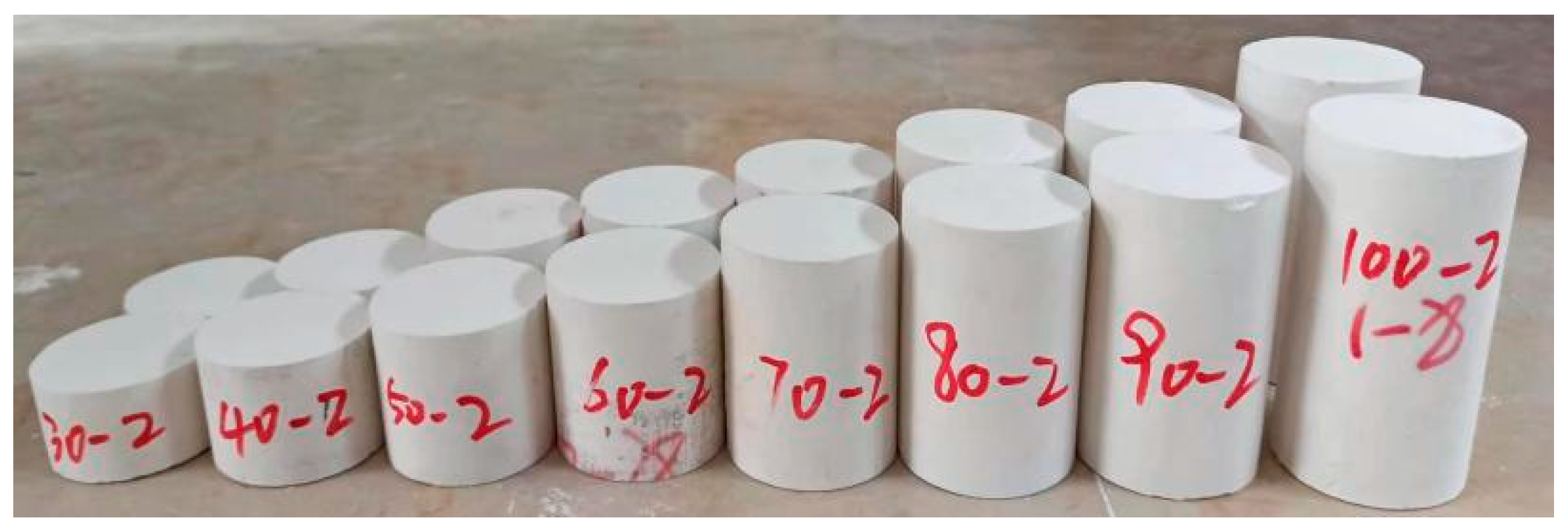
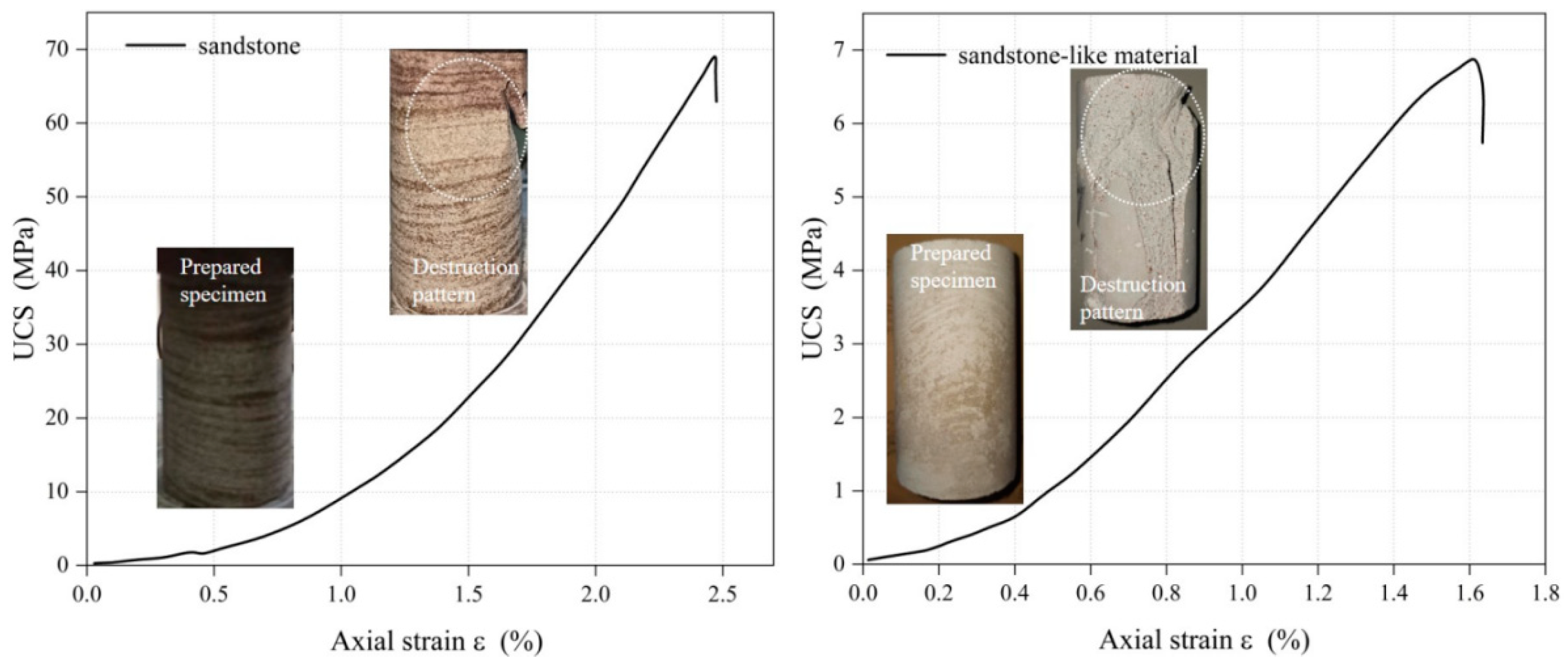

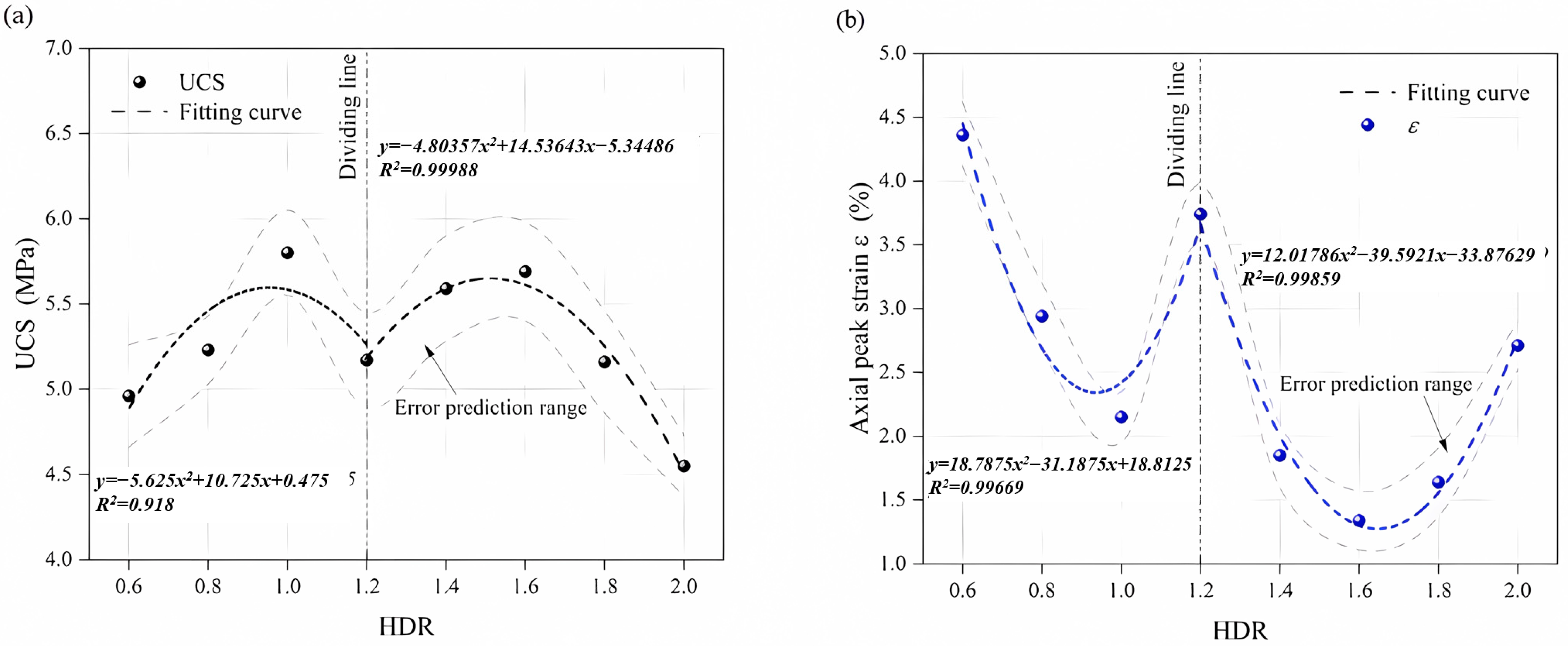

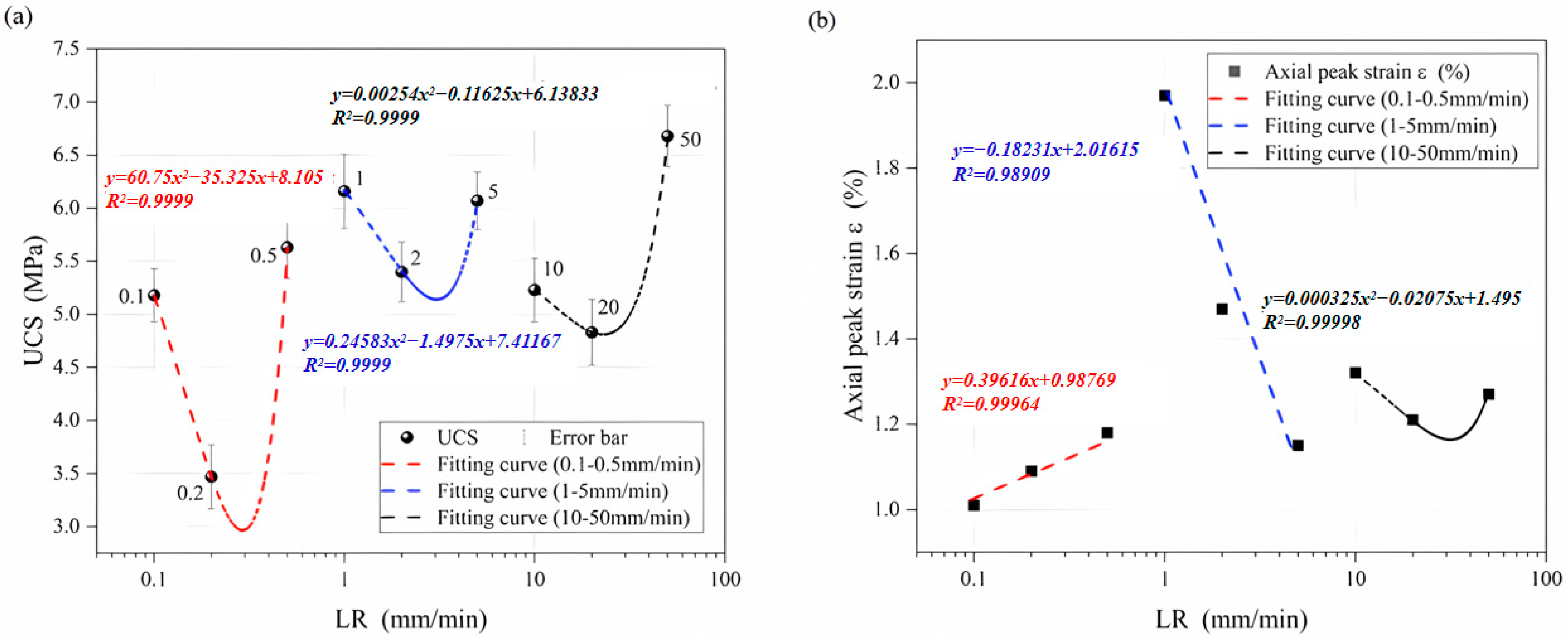
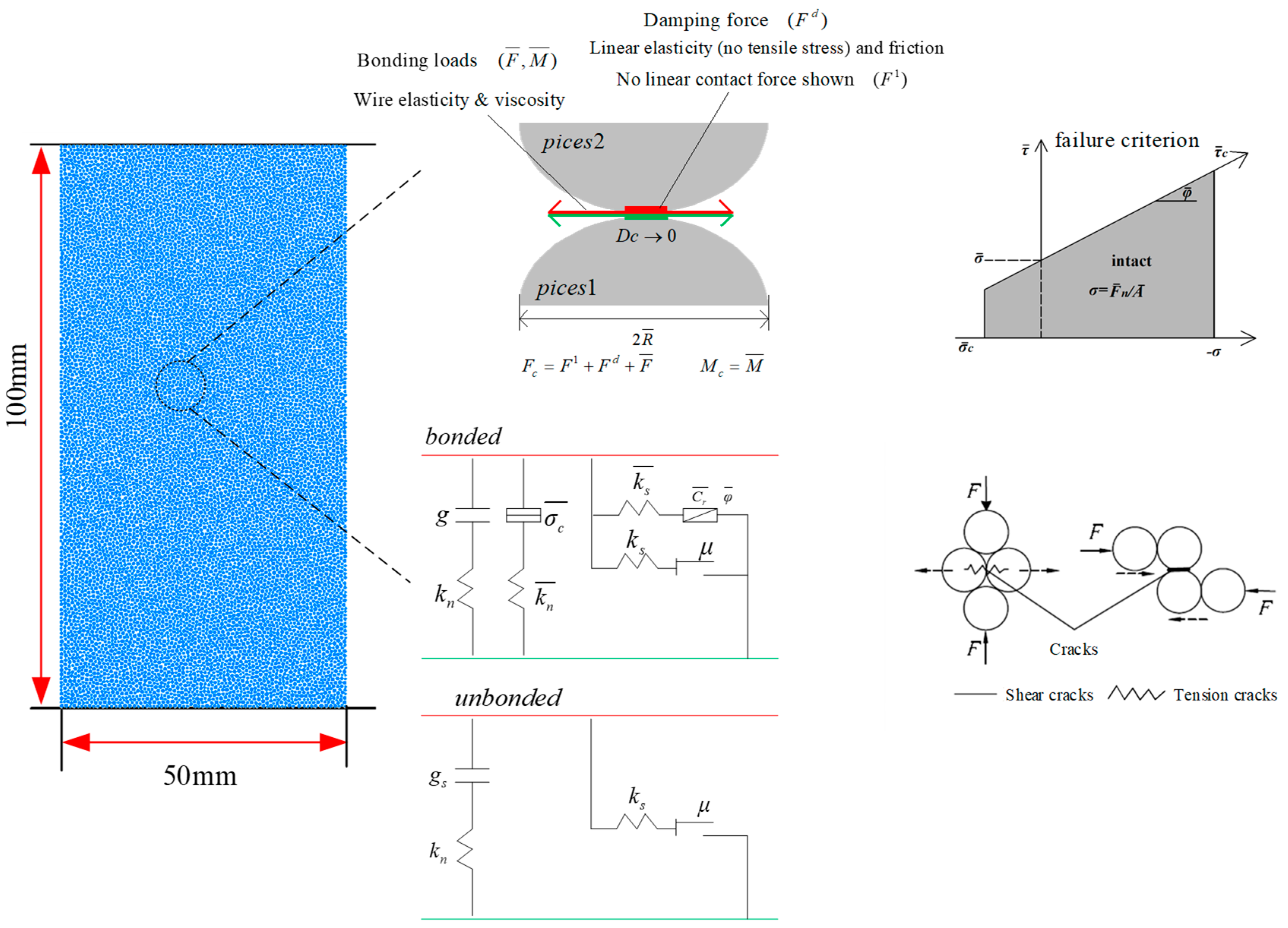
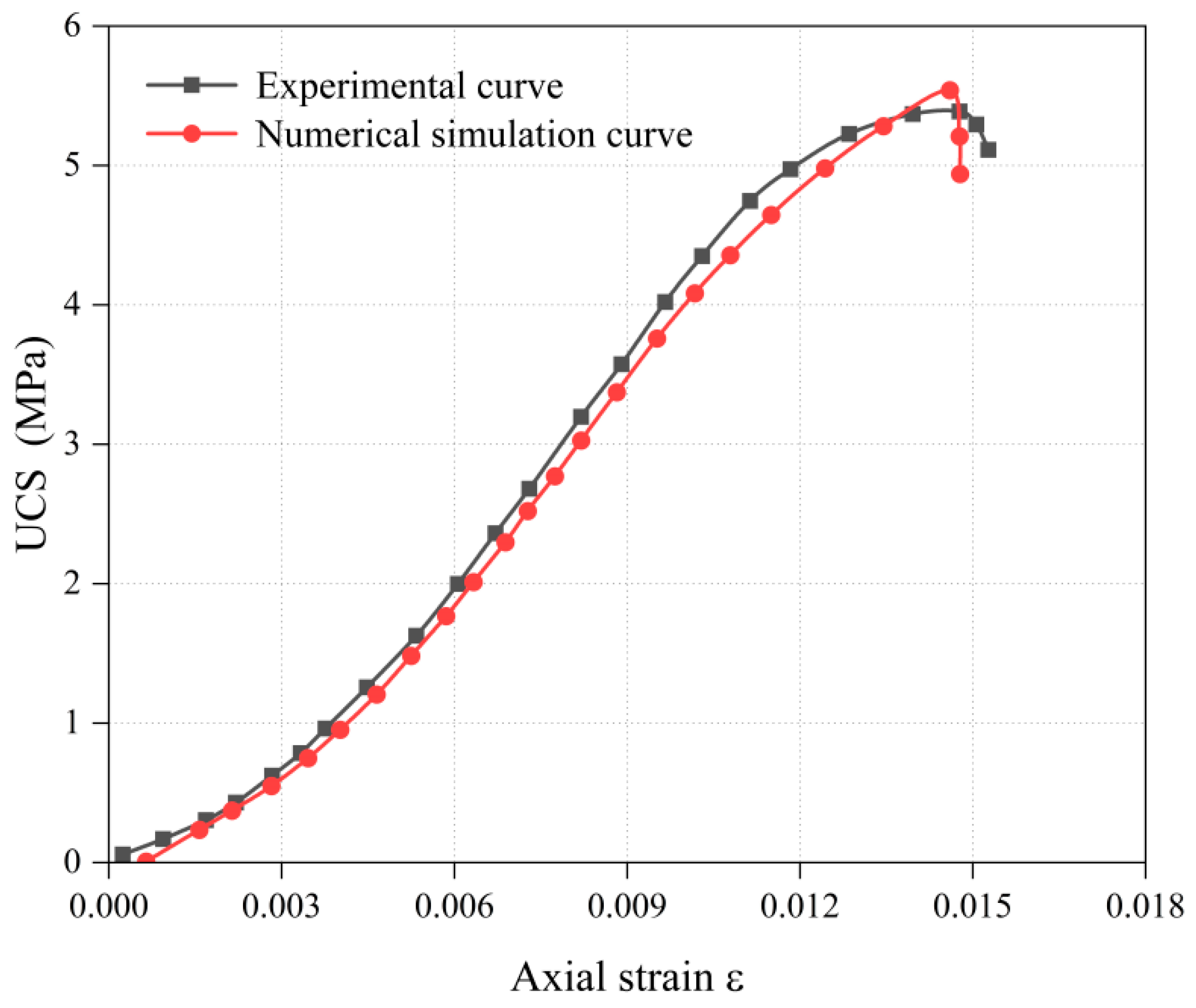
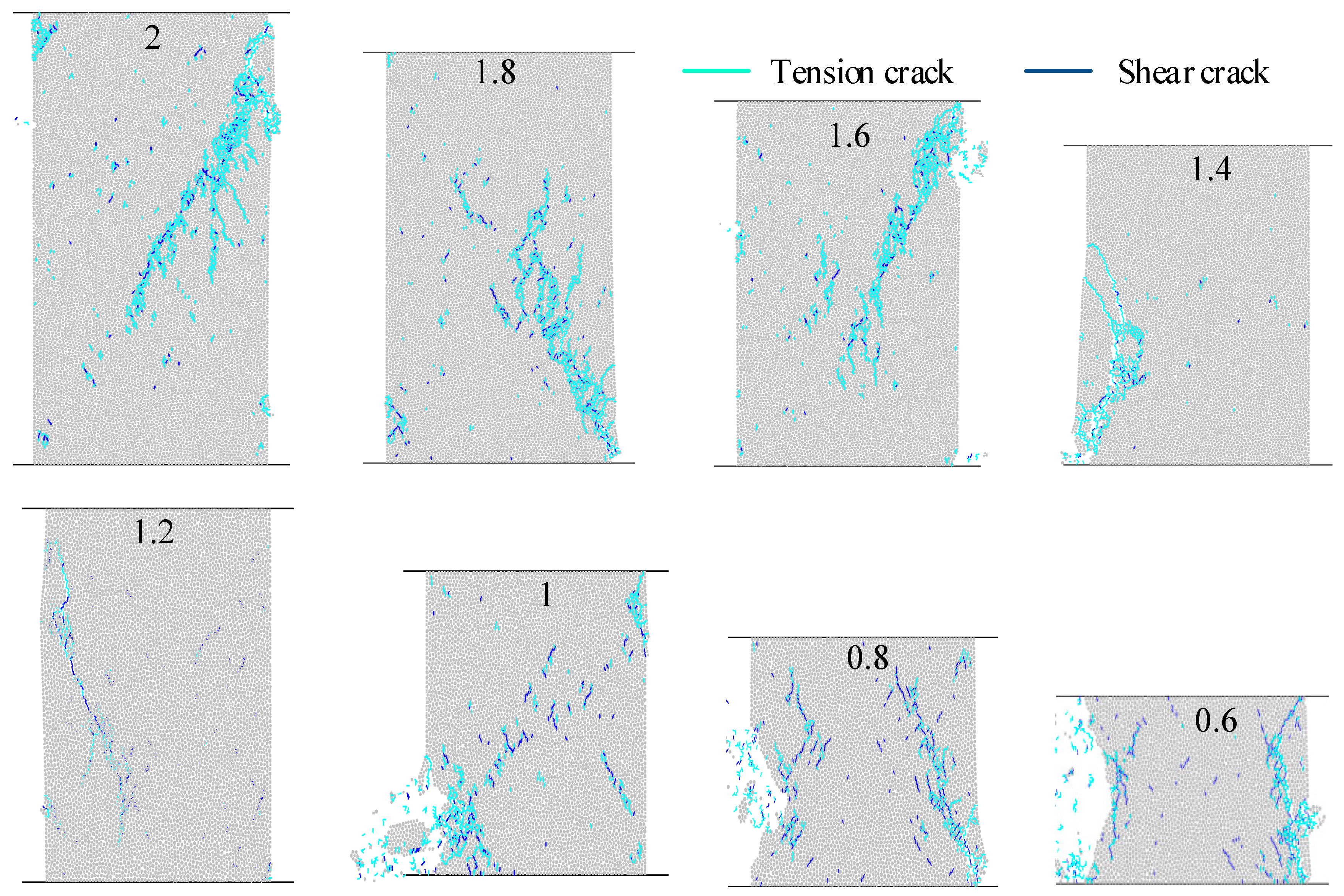

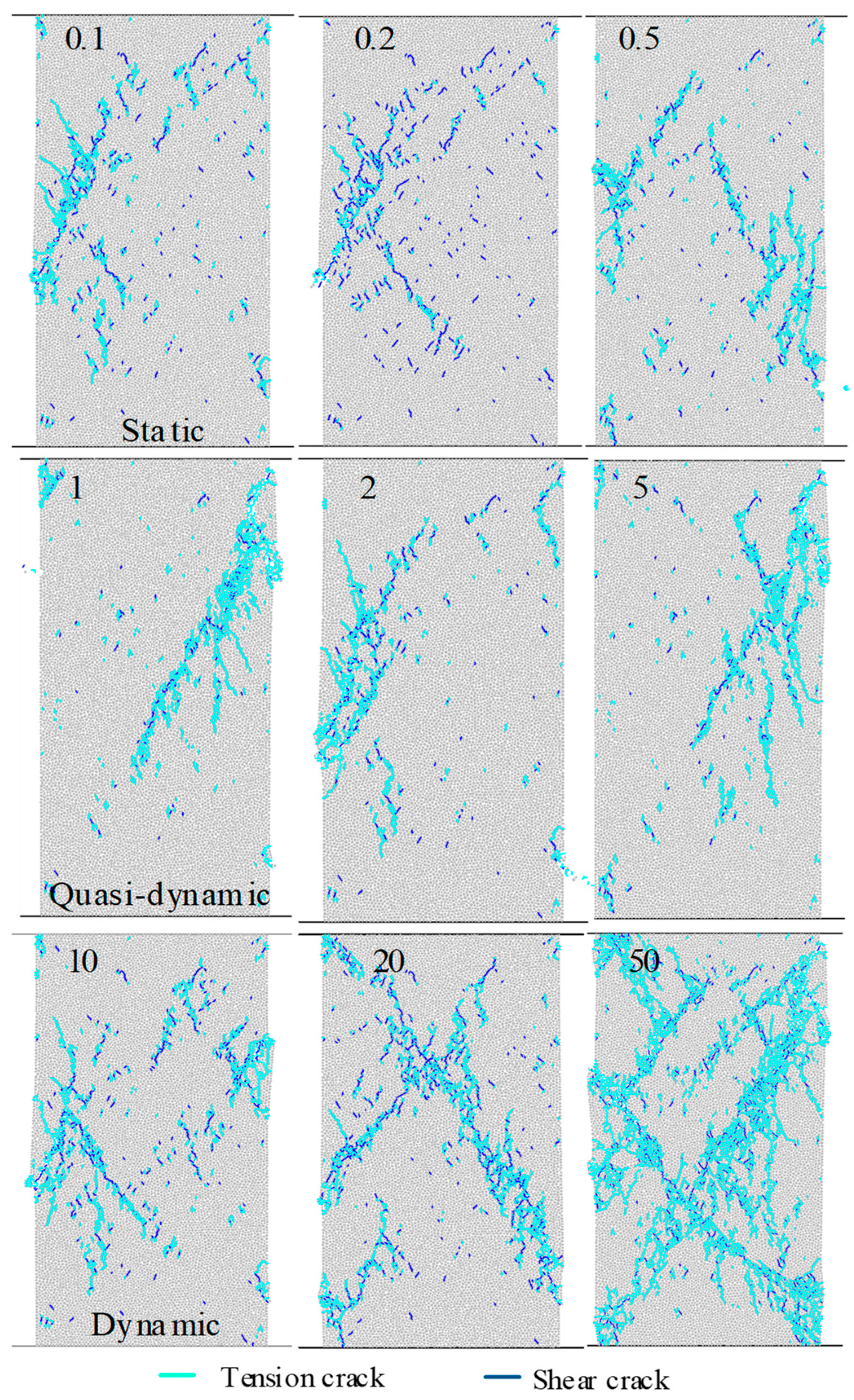
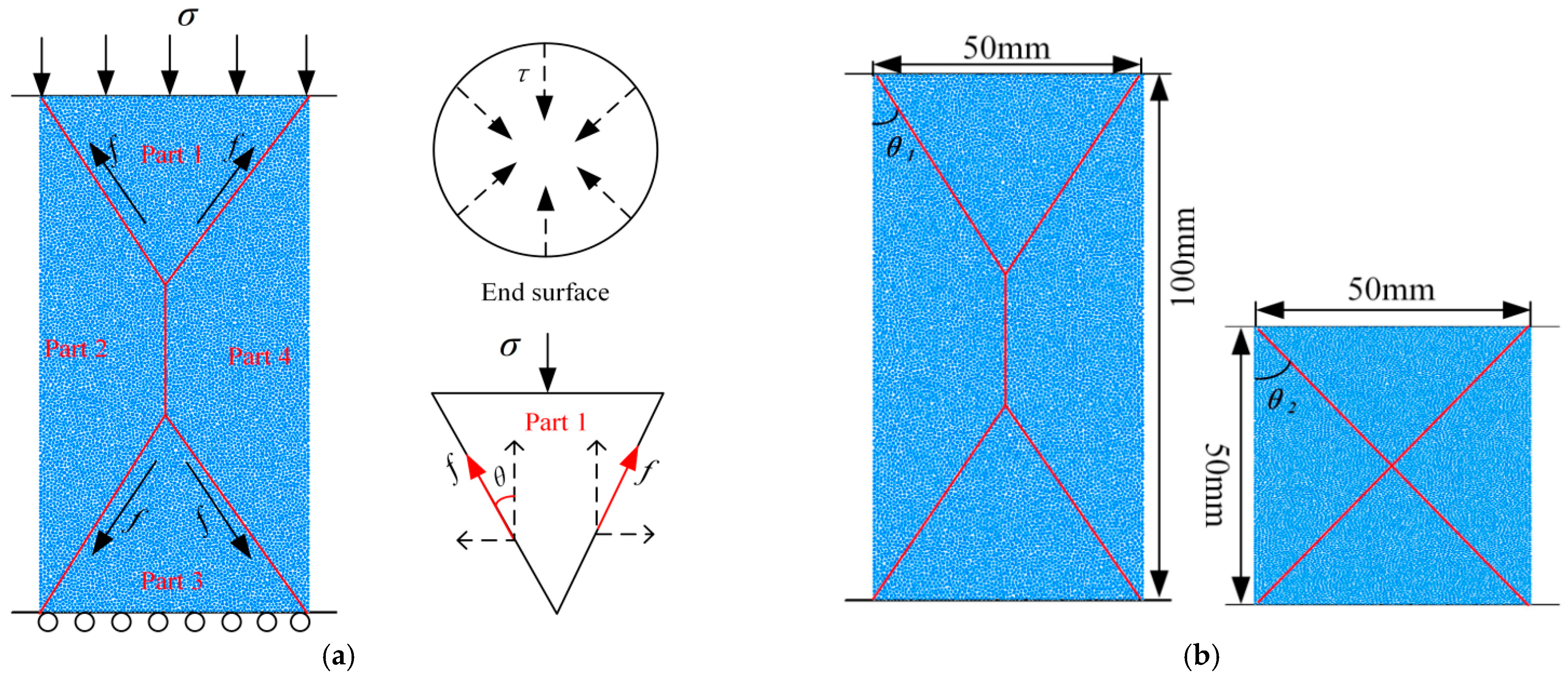
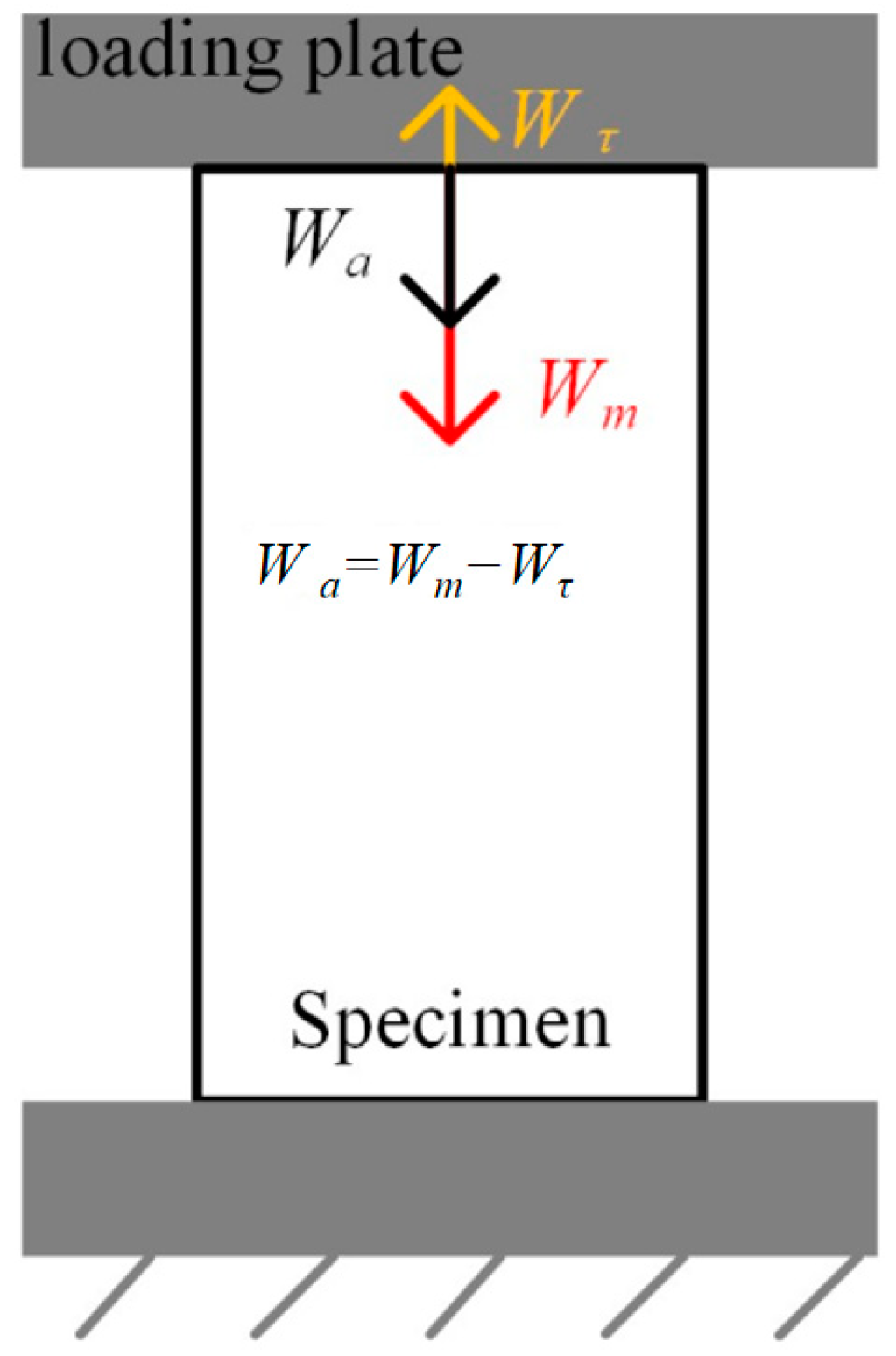
| Ingredients | Size (Mesh) | Ratio | Dosage (%) |
|---|---|---|---|
| River sand | 9, 16 and 32 | 1/3 of each particle size | 7.5 |
| Quartz sand | 200 and 600 | 1/2 of each particle size | 17.5 |
| -high-strength gypsum powder | 180 | / | 58.3 |
| Water | / | / | 16.7 |
| Type | ρ (g·cm−3) | UCS (MPa) | Em (GPa) | Axial Peak Strain (%) | v |
|---|---|---|---|---|---|
| Sandstone | 2.64 | 69.2 | 3.68 | 2.3 | 0.21 |
| Sandstone-like material | 1.33 | 6.96 | 0.53 | 1.6 | 0.23 |
| SR (s−1) | Load Condition |
|---|---|
| <10−5 | Static |
| 10−5~10−3 | Quasi-dynamic |
| >10−3 | Dynamic |
| LR (mm·min−1) | HDR | SR (s−1) | Load Condition | UCS (MPa) | Axial Peak Strain (%) |
|---|---|---|---|---|---|
| 0.8 | 0.6 | 4.44 × 10−4 | Quasi-dynamic | 4.96 | 4.36 |
| 0.8 | 3.33 × 10−4 | Quasi-dynamic | 5.23 | 2.94 | |
| 1 | 2.67 × 10−4 | Quasi-dynamic | 5.8 | 2.15 | |
| 1.2 | 2.22 × 10−4 | Quasi-dynamic | 5.17 | 3.74 | |
| 1.4 | 1.90 × 10−4 | Quasi-dynamic | 5.59 | 1.85 | |
| 1.6 | 1.67 × 10−4 | Quasi-dynamic | 5.69 | 1.34 | |
| 1.8 | 1.48 × 10−4 | Quasi-dynamic | 5.16 | 1.64 | |
| 2 | 1.33 × 10−4 | Quasi-dynamic | 4.55 | 2.71 | |
| 0.1 | 2 | 1.67 × 10−5 | Static | 5.18 | 1.01 |
| 0.2 | 3.32 × 10−5 | Static | 3.47 | 1.09 | |
| 0.5 | 8.32 × 10−5 | Static | 5.63 | 1.18 | |
| 1 | 1.67 × 10−4 | Quasi-dynamic | 6.16 | 1.97 | |
| 2 | 3.39 × 10−4 | Quasi-dynamic | 5.40 | 1.47 | |
| 5 | 8.30 × 10−4 | Quasi-dynamic | 6.07 | 1.15 | |
| 10 | 1.66 × 10−3 | Dynamic | 5.23 | 1.32 | |
| 20 | 3.32 × 10−3 | Dynamic | 4.83 | 1.21 | |
| 50 | 8.32 × 10−3 | Dynamic | 6.68 | 1.27 |
Disclaimer/Publisher’s Note: The statements, opinions and data contained in all publications are solely those of the individual author(s) and contributor(s) and not of MDPI and/or the editor(s). MDPI and/or the editor(s) disclaim responsibility for any injury to people or property resulting from any ideas, methods, instructions or products referred to in the content. |
© 2024 by the authors. Licensee MDPI, Basel, Switzerland. This article is an open access article distributed under the terms and conditions of the Creative Commons Attribution (CC BY) license (https://creativecommons.org/licenses/by/4.0/).
Share and Cite
Gou, Y.; Bai, J.; Li, Y.; Zhao, X.; Tai, L.; Fu, Z. Investigating the Effects of the Height-to-Diameter Ratio and Loading Rate on the Mechanical Properties and Crack Extension Mechanism of Sandstone-Like Materials. Appl. Sci. 2024, 14, 10049. https://doi.org/10.3390/app142110049
Gou Y, Bai J, Li Y, Zhao X, Tai L, Fu Z. Investigating the Effects of the Height-to-Diameter Ratio and Loading Rate on the Mechanical Properties and Crack Extension Mechanism of Sandstone-Like Materials. Applied Sciences. 2024; 14(21):10049. https://doi.org/10.3390/app142110049
Chicago/Turabian StyleGou, Yunbo, Jianbiao Bai, Yanhui Li, Xiangqian Zhao, Lianhai Tai, and Zizhao Fu. 2024. "Investigating the Effects of the Height-to-Diameter Ratio and Loading Rate on the Mechanical Properties and Crack Extension Mechanism of Sandstone-Like Materials" Applied Sciences 14, no. 21: 10049. https://doi.org/10.3390/app142110049
APA StyleGou, Y., Bai, J., Li, Y., Zhao, X., Tai, L., & Fu, Z. (2024). Investigating the Effects of the Height-to-Diameter Ratio and Loading Rate on the Mechanical Properties and Crack Extension Mechanism of Sandstone-Like Materials. Applied Sciences, 14(21), 10049. https://doi.org/10.3390/app142110049






